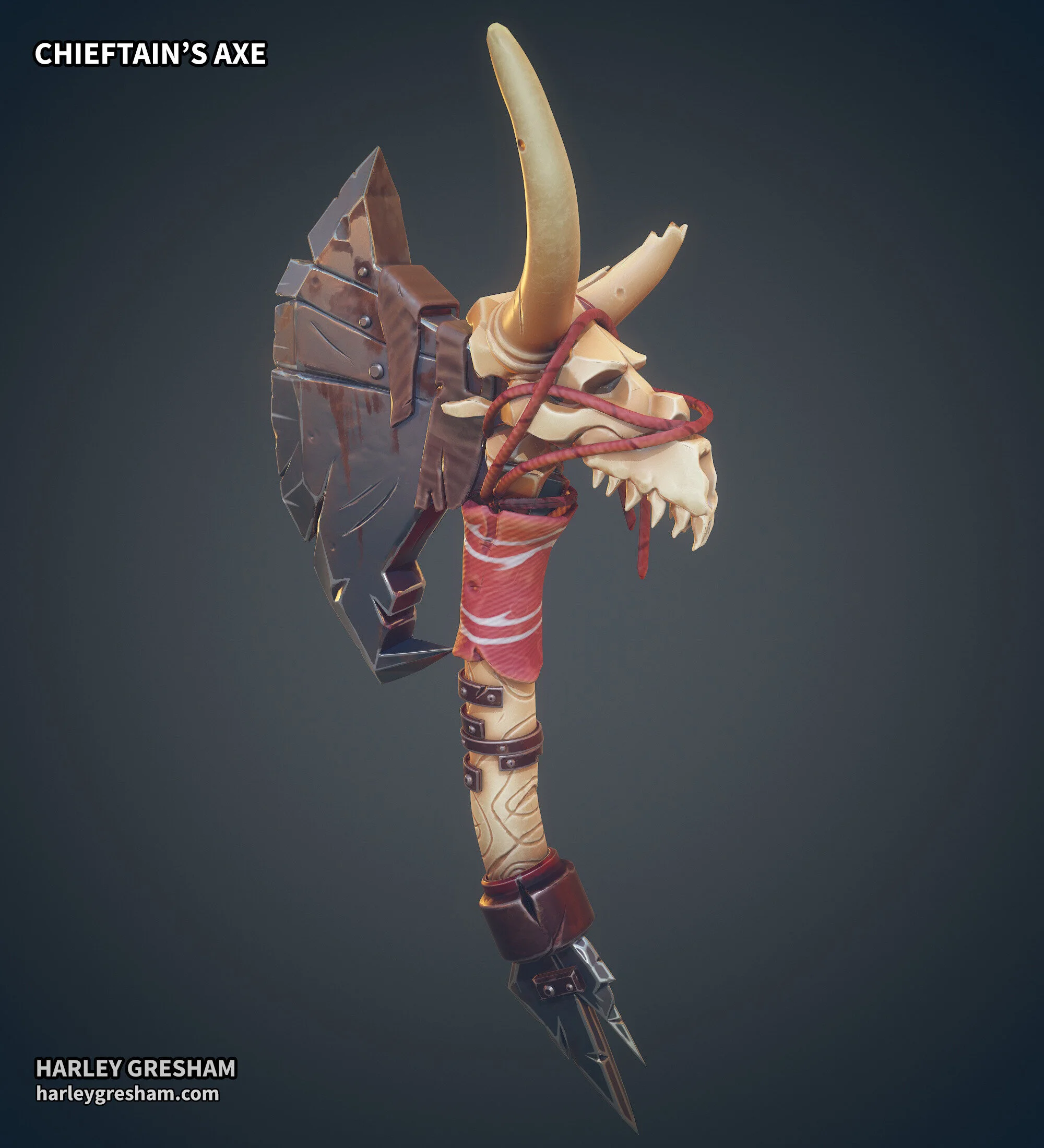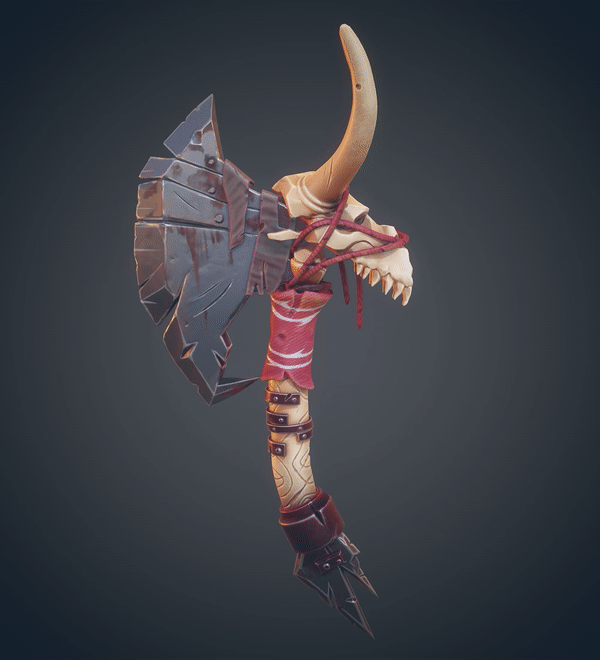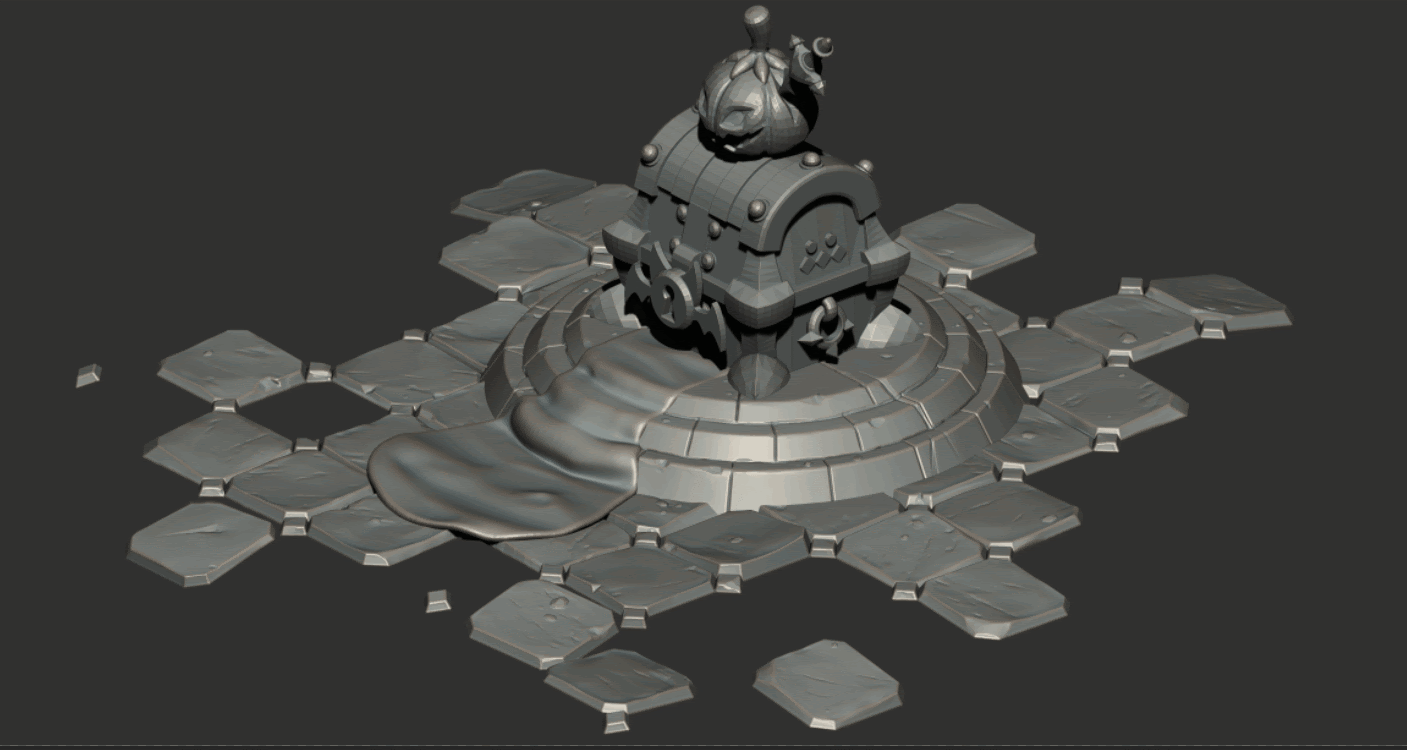Mentee Showcase
With Harley Gresham
With Harley Gresham
In this Mentee Showcase Harley Gresham talks about his experience taking 2 Mentorships with the The Mentor Coalition, discusses the “Chieftans Axe” and “Pumpkin Chest” projects, and sheds some light on the impact the Mentorships have had on him as an artist.

“I would recommend everyone give the coalition a chance! There’s nothing like getting feedback from a professional with current games experience. You literally cannot get this kind of training anywhere else! Seriously, find a mentor you like and sign up!”
G'day, my name is Harley Gresham, a 3d environment artist from Australia, living in Japan. This year is my first in the games industry; I got my first games job in March at Senju Kobo, a small background art outsourcing company in Tokyo. Before Japan, I studied Games Design at University in Australia in 2014 but struggled to find any jobs in Australia at the time and ended up teaching English in Japan. Since 2017, while living in Japan, I've been studying 3D art, particularly environment art.
I came across The Mentor Coalition this year via Twitter and it felt like a mentorship was just what I needed to level up. I wanted to do something non-realistic for a change, so I checked out Dylan Melott's mentorship and was deeply impressed by his work on Paladins and personal pieces. So, it was an easy choice taking the Stylized Art Mentorship back in February.
The First Mentorship
Dylan helped me produce my Chieftain's axe (https://www.artstation.com/artwork/8lJEVR) and I picked up a ton of useful workflow habits and techniques during the mentorship. It was so much fun to make that it convinced me stylized art was what I wanted to focus on.
Dylan was very kind and patient and went far beyond the amount of time and feedback I would ever have expected. I always looked forward to the sessions and the feedback I'd get from him. He made it incredibly easy to understand through annotated pictures and gif breakdowns. I talked about the first mentorship in this 80.lv interview, (https://80.lv/articles/001agt-stylized-prop-art-modeling-and-retopology-in-maya/) So I'll talk about the second mentorship I took with Dylan in June instead!




The Second Mentorship
Second time around with Dylan, I was feeling much more confident with stylized sculpting, so I wanted this time to focus more on hand-painting. I gave Dylan ten concept art pieces I'd found and he helped me narrow it down to two that weren't too complicated to model, but had enough material variety to be interesting to paint. We eventually settled on Woo Kyungzin's pumpkin chest. (https://www.artstation.com/artwork/n5y5X)


Before the first meeting, I came up with my first block-in and we discussed a few things about how I should go about mirroring parts of the model to save UV space. This is something I had done before but not thought much of. It ended up being a big time saver. This time I used Blender's mirror modifier with the UV offset function. We decided that the corner parts could be duplicated, and even the front, but only where it was covered enough so that the symmetry wouldn't be too noticeable. This was something I had to keep in mind later though since it restricts how much unique sculpting and texturing you can add later without looking blatantly mirrored.

Skipping forward to the sculpting part, we kept things pretty simple this time. Something I wanted to improve was to get crisper edges in my sculpt, as I felt the previous project's high poly was a little soft and didn't retain some of the edges properly. When I added damage I kept it pretty simple, although Dylan noted that I was a bit too noisy and had overly detailed some areas so I ended up knocking back even more of it. In general, stylized art benefits best from large areas of rest, and wherever you add detail it should exaggerate what you are going for. Keep those details large and distinctive. As an example, the front lock doesn't have many small details, but where I have added slashes I've gone with generally large shapes.


I think that there is a trap to stylized art in that, a lot of newer stylized artists think that all edges should have a highlight. And while I believe some styles feature uniform edges, it looks odd most of the time. You should think about why you are adding a highlight to the edge. Does it represent the material? Is it to show damage or catch the light? Or is it because you think that's just what you do for this style? In Substance Painter I use the curvature slider in the mask editor to add a uniform edge, then use a noise fill layer set to subtract to chip away at it, and finally add extra detail by hand painting.


Speaking of hand-painting, while I think Painter is still too laggy for bigger projects, it's still a capable tool for most props. One tip I'd give is just to stick to the round brush, at least in the beginning. You can adjust the settings, but just try to do as much as you can with it. You'd be surprised how much you can do with it. I use the standard rounded brush for most work, with a few exceptions. Also, I usually don't paint on to any normal layer, I prefer to use several fill layers with black masks instead. Blending multiple colour layers this way is harder, but its also much less destructive than a normal layer. This means you can easily tweak colours, layer opacity, and roughness and metal values. I like to use generators later, or just fill layers with grunge/patterns to subtract from what I paint. That usually gets me most of the way.
At the end of the project, I had to move house so it forced me to take a break. But, this turned it out to be great since it meant I could wait and reevaluate the project. Some helpful people on the coalition discord suggested it would look better in a mini diorama, so I spent some time on making a dungeon floor/platform for the project which I think ultimately added much more story to the piece. Unfortunately, I wasn't able to finish in June, but Dylan was very kind and kept giving me feedback through August and September.
“The piece of advice that Dylan gave me that continues to resonate the most with me though is that stylized art should look simple and be easy to understand at a distance, but up close there should be areas of detail that reward the viewer for looking closer. This applies to both sculpting and texturing.”
What Impact Did The Mentorship Have On You?
Dylan emphasized the importance of thinking about how the steps I take would affect the project in the latter stages. Not only to reduce the amount of time redoing things but also so I could speed my workflow up. What I am mainly referring to is the high and low process. Dylan stressed the usefulness of a "medium" poly model. By this I mean a model that is not quite high poly (non-smoothed) but also not something suitable as a low-poly game model either. By aiming for an in-between of the two (after the block-in stage), it is much easier to create the high and low poly versions later as you can easily scale up and down. Of course, this all depends on how organic the object is, as sometimes you can't help but have to retopologize, like the pumpkin head in my case.
Also, talking to Dylan affirmed the value of getting feedback as soon as possible. I've always been reluctant to show my work out of fear of looking amateurish, but you can't expect yourself to get better without putting yourself out there. A lot of my previous work would have come out much better if I'd opened myself up to more feedback much more often. It can be painful, but you've gotta get the garbage out of the way before you can make something great.


The piece of advice that Dylan gave me that continues to resonate the most with me though is that stylized art should look simple and be easy to understand at a distance, but up close there should be areas of detail that reward the viewer for looking closer. This applies to both sculpting and texturing.
Mentorship Compared To Traditional Classes
I've done online classes for 3D before, and while these can be nice, the teacher's attention is ultimately split between you and the other students so feedback is never going to be as in-depth and personal as a one-on-one mentorship. With more of the attention of the teacher or mentor, you can also go to them for questions outside of the sessions far more easily.
I would recommend everyone give the coalition a chance! There's nothing like getting feedback from a professional with current games experience. You literally cannot get this kind of training anywhere else! Seriously, find a mentor you like and sign up!
